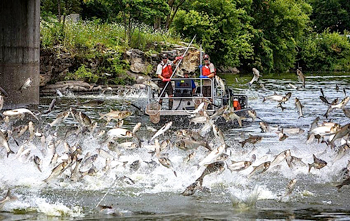Both Maine and Canada Face
Bait Shortages
by Laurie Schreiber

School of Asian carp leaping out of the water. Asian carp grow to 39 to 40 inches long and 40 to 50 lbs. They were introduced into the U.S. by fish farmers in the southern states in the 1960s and 70s to control vegetation and algae blooms. Five species of asian carp have been released or escaped and are breeding in the Mississippi Basin. They are expanding their range. The US Fish & Wildlife Service is concerned that they will breach a narrow barrier in Illinois and enter the Great Lakes. Efforts are under way to attempt to control their expansion. Photo courtesy Ryan Hagerty/U.S. Fish & Wildlife Service.
PORTLAND—In Atlantic Canada, the lobster resource is doing well.
But fishery interests there predict problems with sourcing bait at some point in the future.
Martin Mallet, executive director of the Maritime Fishermen’s Union – which represents 1,200 independent inshore owner-operator fishermen in New Brunswick and Nova Scotia – said Atlantic Canada’s lucrative lobster fishery employs 10,000 lobster fishermen and around 3,000 helpers and 10,000 plant employees.
“It’s economic pillar,” Mallet said.
Mallet spoke at the 15th Canadian/U.S. Lobstermen’s Town Meeting, hosted by the University of Maine Lobster Institute on April 5–6 in Portland.
Canada’s lobster resource appears to be stable, he said. In the southern Gulf of St. Lawrence, recruitment of small lobsters, from 2003 to 2016, is going up.
“We’re seeing lots of lobsters coming into the system,” he said.
But, he said, decreased bait stocks are becoming an issue.
For each pound of bait used, Canadian lobstermen land three pounds of lobsters, he noted.
Herring and mackerel are preferred baits, but Atlantic Canada also uses other species shipped from around the world.
“It could become a problem, but it’s not an issue on our radar now,” he continued. “IF there are issues with these supplies, there may be issues at some point to land our lobsters.”
Herring stocks in Atlantic Canada have decline since 2010, he said. With less locally sourced bait, prices of bait are increasing somewhat, he said.
Department of Marine Resources (DMR) Coordinator Nicholas Popoff said the DMR is looking at biosecurity protocols for bringing outside sources of bait into the Gulf of Maine, given the 70 percent coastwide reduction in herring quota this year.
The DMR has been contacted by other states interested in marketing invasive species as alternative baits. That includes Asian carp from Illinois and blue catfish from Maryland. The latter is native to the United States but not to Chesapeake Bay, he said.
“We’re working with the state of Maryland to understand that market,” Popoff said.
Another untapped bait source might be menhaden from the Gulf of Mexico, he said.
